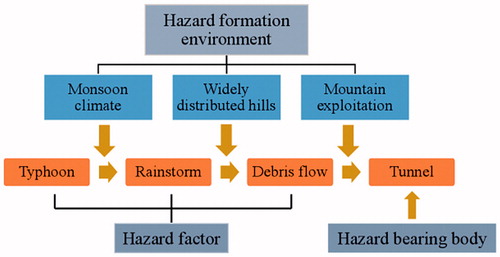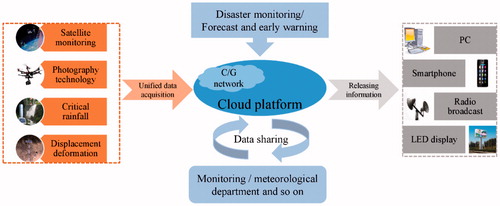 ?Mathematical formulae have been encoded as MathML and are displayed in this HTML version using MathJax in order to improve their display. Uncheck the box to turn MathJax off. This feature requires Javascript. Click on a formula to zoom.
?Mathematical formulae have been encoded as MathML and are displayed in this HTML version using MathJax in order to improve their display. Uncheck the box to turn MathJax off. This feature requires Javascript. Click on a formula to zoom.Abstract
Typhoons have inflicted significant damage and loss of life to China, a large number of typhoon–rainstorm–debris flow–tunnel accidents occur in the southeastern coastal areas each year. Considering the disaster prevention and mitigation decision-making of disaster accidents in coastal areas and the reduction of regional economic losses, this Express Letter presents some typical accident scenes and rescue measures in recent years and analyses the hazard mechanism from three aspects. On this basis, we propose some suggestions such as the monitoring and early-warning system, which can provide a few references for reducing disaster losses and improving disaster treatments.
1. Introduction
Historically, the southeastern coastline of China is prone to suffer typhoon each year () (Zhang et al. Citation2011, Citation2018 Yap et al. Citation2015). Typhoons are often accompanied by strong winds, rainstorms and storm surges which have the characteristics of high frequency, sudden occurrence and wide range of influence and great intensity of disaster (Yin et al. Citation2013). In the vulnerable area of geological environment, the rainstorm caused by typhoons is easy to trigger geological disasters such as collapse, landslide and debris flow and bring about heavy casualties and property losses. A large area of mountainous region is located in the southeast coast, owing to the advantages tunnels have such as overcoming topography or elevation obstacles, improving the linear and shortening mileage that the demand is determined to build more mountain tunnels when building rail or highway projects in these areas (Vu et al. Citation2015; Luo et al. Citation2018; Qiu et al. Citation2018a,b). Typhoon disasters greatly increase the vulnerability of traffic facilities and the susceptibility of disaster chain in southeast coastal area (Li et al. Citation2014; Lai et al. Citation2016a; Yan et al. Citation2018a,b; Zhang, Wang, et al. Citation2018). An increasing number of tunnels are constructed in disadvantageous environments (Lai et al. Citation2015, Citation2016b,c, Citation2018a,Citationb; Luo et al. Citation2019; Li, Qi, et al. Citation2018; Qiu et al. Citation2018c,Citationd), the typhoon–rainstorm–debris flow disasters constitute serious threats to mountain tunnels. The Express Letter briefly reports the tunnel debris flow accidents triggered by typhoons in southeast coastal area of China in current years and discusses the hazard mechanism of typhoon–rainstorm–debris flow–tunnel accidents(Li, Wang, et al. Citation2018; Li, Xu, et al. Citation2018c; Qiao et al. Citation2018a,Citationb).
Figure 1. Typhoon path and its influence range. Sources: http://www.weather.com.cn/ and re-drawn by authors.

2. Operation tunnel debris flow disaster
2.1. Overview
In this paper, some typical tunnel debris flow accidents triggered by typhoons in southeast coastal area in last several years are presented (). To review the previous tunnel debris flow disasters triggered by typhoon, the occurrence period of accidents is more concentrated in June to October, which is the high frequency season of typhoon. Concretely, four typical accidents occurred in Zhejiang province (), one typical accident occurred in Fujian province (), two typical accidents occurred in Guangdong province ().
Figure 2. Location of the accident. Sources: http://map.baidu.com/ and re-drawn by authors.

Figure 3. Disaster scenes in Zhejiang province: SDL tunnel (a, b); LTW tunnel (c, d); BLT tunnel (e); DZY tunnel (f). Sources: http://news.66wz.com/system/2013/10/07/103828122.shtml and http://zjnews.zjol.com.cn/system/2013/10/07/019628229.shtml and http://nb.ifeng.com/app/nb/detail_2015_07/12/4099629_0.shtml and http://www.703804.com/thread-15909243-1-1.html.
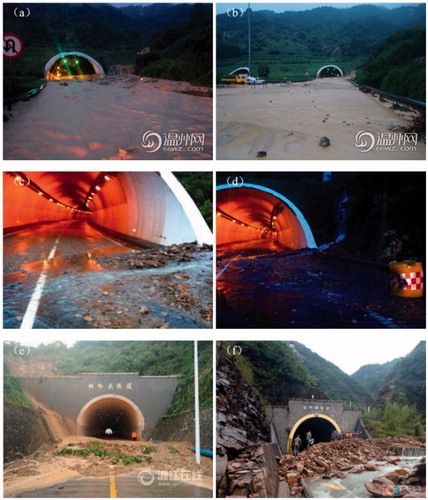
Figure 4. Disaster scenes in Fujian province: XJK tunnel. Sources: http://www.sohu.com/a/149289635_691795.
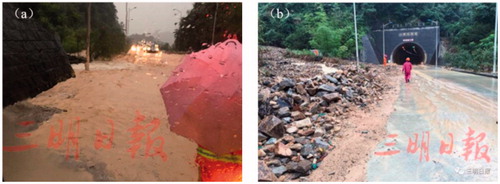
Figure 5. Disaster scenes in Guangdong province: JMS tunnel (a, b); Mud rock flowed into the train (c); The damaged train (d). Sources: http://news.sohu.com/20120726/n349075089.shtm and http://weibo.com/ and http://www.guancha.cn/society/2013_08_20_166817.shtml.

Figure 6. Rescue scenes: Rescuer cleaned up debris flows in BLT tunnel (a, b); Rescue site in DZY tunnel (c, d); Excavators shoveled mud-rock in JMS tunnel (e, f). Sources: http://nb.ifeng.com/app/nb/detail_2015_07/12/4099629_0.shtml and http://news.k618.cn/society/201609/t20160917_8970135.html and http://news.sohu.com/20120726/n349075089.shtml.
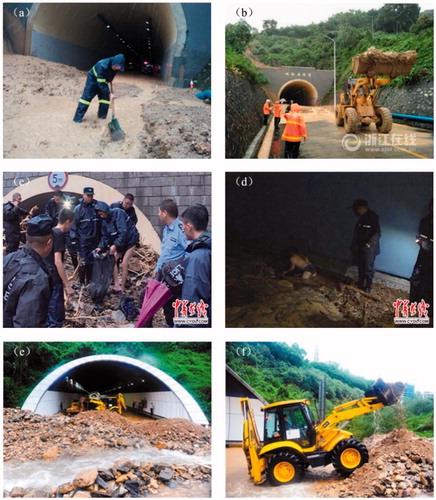
Table 1. Accidents occurred in Zhejiang province: Sources: http://news.66wz.com/system/2013/10/07/103828122.shtml and http://zjnews.zjol.com.cn/system/2013/10/07/019628229.shtml and http://china.huanqiu.com/hot/2015-07/6975523.html and http://www.703804.com/thread-15909526-1-1.html and http://bbs.703804.com/thread-15909155-1-1.html and recounted by authors.
Table 2. Accidents occurred in Fujian province: Sources: http://www.sohu.com/a/149289635_691795 and recounted by authors.
Table 3. Accidents occurred in Guangdong province: Sources: http://news.enorth.com.cn/system/2012/07/27/009717985.shtml and http://365jia.cn/news/2013-08-20/5E846E601FF265FE.html and recounted by authors.
2.2. Rescue measures
After the dangerous omen occurred, the tunnel management unit immediately identified the accident from the monitoring system or the highway patrol, then controlled information boards and traffic lights to close the tunnel. Tunnel maintenance supervision unit immediately started emergency plan: (1) Carry out traffic control in the tunnel section and divert traffic; (2) Organize rescue personnel and emergency machinery to the accident site at once; (3) Set up on-site command and carry out on-site emergency command right away. After the barrier had been set up, rescue personnel transferred personnel and vehicles to a refuge urgently and sent injured personnel to on-site medical staff or nearby hospitals. Subsequently, the machinery and equipment were organized to rush to repair roads. To resume traffic as soon as possible, large engineering vehicles and excavating machinery were invoked to clear the gravel, mud and water of accident section ().
3. Hazard mechanism
The necessary conditions leading to debris flow include topographic conditions, material reserves and excitation conditions. The geological structure and topography have provided favourable conditions for the development of debris flow in Southeast China, such as a large amount of clastic loose sediments, and the place for debris flow formation, movement and accumulation. Rainstorm is the source and component of debris flow, and it is also the excitation condition and main driving force of most debris flow in Southeast China . Because of rainfall penetration, the soil on the hillside slope became unstable. Then debris flow is formed by mixture of the loose solid substances sliding down from the hillside slope and the water (Chen et al. Citation2013; Hungr et al. Citation2014).
3.1. Hazard factor
Typhoon and rainfall are considered to be hazard factors. The change of typhoon landing place and the impact area of disaster are closely related to moving path (Wang and Ling Citation2010). These typhoons which have caused disasters are all landfall typhoons, frequency of landfall location is shown in . Except Severe Tropical Storm Merbok that generated in South China Sea, other typhoons formed in the Northwest Pacific, the statistics of path type are shown in , typhoons of northwest path account for more than half, which need to be highly valued. Besides typhoon hazard factor, the critical rainfall that triggers debris flow can be determined by effective antecedent rainfall (Rc) and current day rainfall when debris flow occur (Rd). The formula for effective rainfall is shown as follow:
(1)
(1)
In the formula, Rc is the effective antecedent rainfall, Rn is the rainfall at n days before the occurrence of debris flow, α is the attenuation coefficient that can be considered as 0.7 during typhoon period. The relationship between Rc and Rd is shown in (Feng et al. Citation2013). Samples of debris flow in the southeast coast of China are collected, F1 and F2 are threshold lines of rainfall. There is no debris flow in area 1, the possibility of debris flow increases in area 2 and lots of debris flow disasters occurred in area 3. If a single parameter of the critical rainfall is considered, the day rainfall when debris flow occurred can be counted as critical rainfall (). When the amount of precipitation is over 200 mm, the risk of disaster is extremely large. The critical rainfall can be based on 100 mm, when the amount of precipitation is over 100 mm, relevant departments need release early-warning and prediction.
3.2. Hazard-formation environment
The southeast coast of China is adjacent to the Western Pacific, tropical cyclones occur frequently, and with the significant impact of subtropical monsoon climate, heavy rainfall and storm surge will occur frequently. The mountains and hills are widely distributed especially in Zhejiang, Fujian, Guangdong and other coastal provinces and the geological conditions are complex with lots of clastic loose sediments. When typhoons land, then climb or round hills, the mountain has induced and forced effects. With feedback effect of typhoon rainstorm, low pressure is beneficial to form and develop, the mountain will strengthen the intensity of typhoon rainstorm. In the hilly areas of the southeast coast, the disaster chain of typhoon–rainstorm–debris flow is prone to be triggered.
Recently, the rapid expansion of urban land and industrial land results in a significant reduction in area of farmland and forest. Urban and engineering construction has gradually extended from plain to mountain area, especially in last several years, large-scale traffic construction, mine exploitation and other mountain engineering construction destroy the stability of mountain and slope, thus the potential risk of geological disasters is increased (Lai et al. Citation2017; Qiu et al. Citation2017; Wang et al. Citation2018a,Citationb). A large number of railway lines and mountain highway cross through the hilly areas, many tunnels have been constructed, which make the soil of fault fracture zone and the mountain with steep slope become more unstable (Lai et al. Citation2016d; Wang, Wang, et al. Citation2018; Wang, Song, et al. Citation2018; Zhang, Li, et al. Citation2018). Thus, landslides and debris flows occur more easily and frequently under the effect of heavy rainfall and gravity.
3.3. Hazard bearing body
With the rapid development of transportation, infrastructure construction is getting faster, at the same time, the destruction of mountainous areas caused by traffic construction leads to tunnels in the hill areas most at risk (Chen et al. Citation2014; Wang et al. Citation2018e). To review the incident scene, tunnel debris flow will easily form the accumulation at the tunnel portal, and lead to water or mudflow rushing into tunnel. Seriously, people and traffic facilities will be washed away by the large mudflow at tunnel portal and traffic is prone to large jam. Disaster mechanism of typhoon disaster chain in coastal areas is shown in .
4. Summary and perspective
Over the past several decades, the economic development has grown fast in the southeast coastal areas. When population and wealth are highly concentrated, a variety of natural disasters is frequently occurring. The period of high risk and profit has arrived (Liu et al. Citation2012, Citation2018a,Citationb). Heavy rainfall caused by typhoons can easily induce mountain landslides, debris flow and other geological disasters in southeast coastal area (Hong et al. Citation2010; Nie et al. Citation2018; Ren et al. Citation2018a,b). In view of current situation, it is vital to investigate disaster prevention further.
(1) The study on the distribution law of debris flow in coastal areas of SE China should be improved. For tunnel debris flow hazard-prone areas, Air–Space–Ground Stereo monitoring network can be carried out (). "Air" means applying oblique photography technology of low-altitude unmanned aerial vehicle (UAV). "Space" implies the application of GNSS satellite monitoring system that can implement dynamic monitoring of all-day and all-weather in the area of geologic hazard. "Ground" means using 3D laser scanning and measuring robot to monitor depth displacement of soil. With the application of Air–Space–Ground 3D monitoring network, accurate and reliable dynamic monitoring data will be provided for the implementation of emergency investigation and treatment project in disaster areas, a security network with high degree of informatization, strong sensitivity of reaction, and timely early warning of geological disasters will be constructed, the smooth progress of the geological disaster treatment project is ensured effectively.
(2) After improvement of monitoring system, the perfect early-warning mechanism of debris flow disasters ought to be established (). The study of the relationship between disasters and monitoring data such as rainfall or deformation should be strengthened and the rationality of forecasting methods and the timeliness of forecasting need to be advanced. Unified data acquisition platform needs to be established to analyse the potential links between various data. Cloud platform should share and exchange information with various departments. After information has been summarized and processed, warning platform uniformly release to the masses through different ways.
(3) The land use structure can be adjusted reasonably. To evaluate the present situation of land use and the risk of geologic hazard. It is necessary to attach importance to ecological construction and human activities. The land use of urban construction and traffic construction should be controlled (Wang and Ling Citation2010; Wang et al. Citation2012; Zhou et al. Citation2017, Citation2019; Zheng et al. Citation20Citation19a,b). Then, restoring vegetation in the area of debris flow in order to consolidate topsoil, reduce water loss and soil erosion.
(4) Comprehensive treatment of engineering measures and relocation can be carried out. Major engineering construction should avoid high risk areas of geologic hazard. Traffic engineering facilities that cannot be relocated could construct corresponding diversion, blocking, drainage and other projects.
(5) After disasters occur, all departments and related areas are supposed to establish advantageous cooperative linkage and information sharing mechanism, so as to ensure the efficient and orderly response.
Acknowledgments
This work is financially supported by the National Key R&D Program of China (No. 2018YFC0808706); the Project on Social Development of Shaanxi Provincial Science and Technology Department (No. 2018SF-378).
No potential conflict of interest was reported by the authors.
Disclosure statement
Figure 7. Frequency of typhoon landfall place. Sources: http://typhoon.zjwater.gov.cn/ and re-drawn by authors.
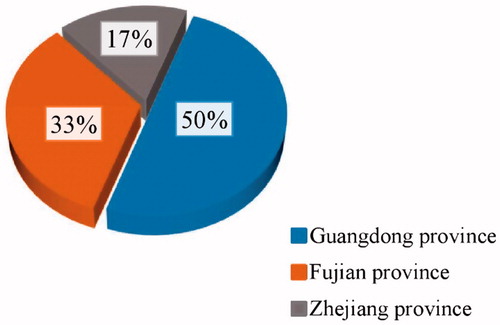
Figure 8. Type of typhoon path. Sources: http://typhoon.zjwater.gov.cn/ and re-drawn by authors.
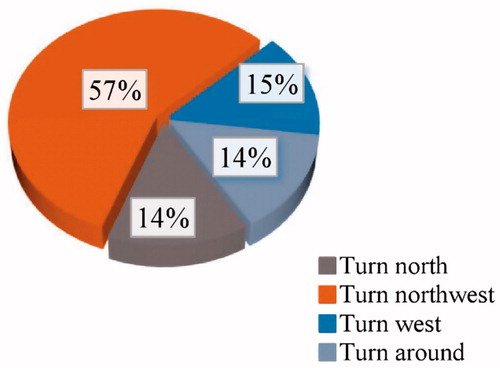
Figure 9. Relationship between effective antecedent rainfall (Rc) and the current day rainfall when debris flow occurred (Rd) in typhoon–debris flow disaster chain. Sources: re-drawn by authors (Feng et al. Citation2013).
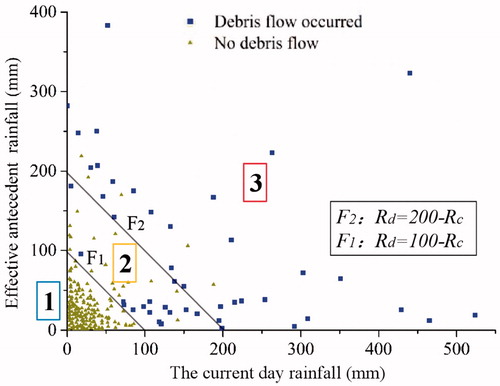
Figure 10. Critical rainfall of disaster location. Sources: http://zjnews.zjol.com.cn/system/2013/10/07/019629063.shtml and http://www.weather.com.cn/zt/tqzt/352008.shtmlhttp://baidu.com and http://news.163.com/16/0916/11/C1363C4O000146BE.html and http://fj.qq.com/a/20170612/004631.htm and http://typhoon.weather.com.cn/tfzt/677335.shtml and http://gd.weather.com.cn/zt/qxrzt/1944273.shtml and re-drawn by authors.
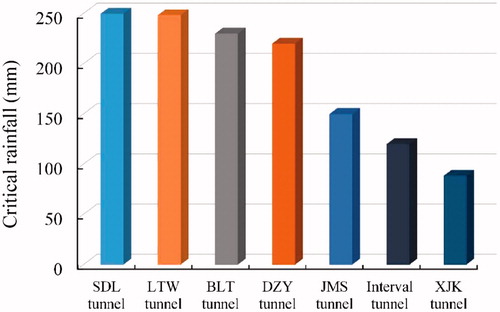
Figure 12. Air–space–ground monitoring system. Sources: http://www.cigem.gov.cn/auto/db/detail.aspx?db=1006&rid=37359&md=15&pd=210&msd=11&psd=5&mdd=11&pdd=5&count=20 and re-drawn by authors.
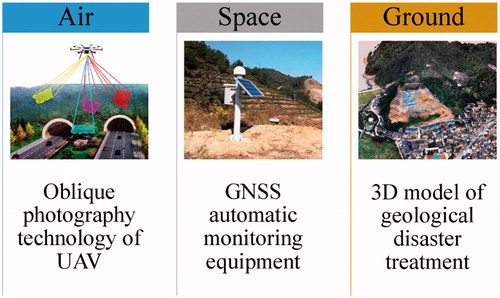
References
- Chen G-Q, Huang R-Q, Xu Q, Li T-B, Zhu M-L. 2013. Progressive modelling of the gravity-induced landslide using the local dynamic strength reduction method. J Mt Sci. 10(4):532–540. doi:10.1007/s11629-013-2367-4.
- Chen G, Li T, Zhang G, Yin H, Zhang H. 2014. Temperature effect of rock burst for hard rock in deep-buried tunnel. Nat Hazards. 72(2):915–926. doi:10.1007/s11069-014-1042-6.
- Feng HJ, Tang XM, Zhou AG. 2013. Study on relationship between rainfall duration and occurrence of debris flow in Zhejiang Province and its application examination. J Nat Disast. 22(1):159–168. 1004-4574(2013)01-0159-10 (in Chinese).
- Hong CC, Lee MY, Hsu HH and Kuo JL. 2010. Role of submonthly disturbance and 40–50 day ISO on the extreme rainfall event associated with Typhoon Morakot (2009) in Southern Taiwan. Geophys Res Lett. 37(8):457–466. doi:10.1029/2010GL042761.
- Hungr O, Leroueil S, Picarelli L. 2014. The Varnes classification of landslide types, an update. Landslides. 11(2):167–194. doi:10.1007/s10346-013-0436-y.
- Lai J, Qiu J, Chen J, Fan H, Wang K. 2015. New technology and experimental study on snow-melting heated pavement system in tunnel portal. Adv Mater Sci Eng. 2015:1. doi:10.1155/2015/706536.
- Lai J, Mao S, Qiu J, Fan H, Zhang Q, Hu Z, Chen J. 2016. Investigation progresses and applications of fractional derivative model in geotechnical engineering. Math Probl Eng. 1. 2016. doi:10.1155/2016/9183296.
- Lai J, Qiu J, Fan H, Chen J, Xie Y. 2016. Freeze–proof method and test verification of a cold region tunnel employing electric heat tracing. Tunnell Underground Space Technol. 6056–6065. doi:10.1016/j.tust.2016.08.002.
- Lai J, Qiu J, Fan H, Zhang Q, Hu Z, Wang J, Chen J. 2016. Fiber Bragg grating sensors-based in situ monitoring and safety assessment of loess tunnel. J Sens. 1. doi:10.1155/2016/8658290.
- Lai J, Wang K, Qiu J, Niu F, Wang J, Chen J. 2016. Vibration response characteristics of the cross tunnel structure. Shock Vib. 2016:1. doi:10.1155/2016/9524206.
- Lai JX, He SY, Qiu JL, Chen JX, Wang LX, Wang K, Wang JB. 2017. Characteristics of seismic disasters and aseismic measures of tunnels in Wenchuan earthquake. Environ Earth Sci. 76:94. doi:10.1007/s12665-017-6405-3.
- Lai J, Wang X, Qiu J, Zhang G, Chen J, Xie Y, Luo Y. 2018a. A state-of-the-art review of sustainable energy based freeze proof technology for cold-region tunnels in China. Renew Sustain Energy Rev. 82:3554–3569. doi:10.1016/j.rser.2017.10.104.
- Lai J, Wang X, Qiu J, Chen J, Hu Z, Wang H. 2018b. Extreme deformation characteristics and countermeasures for a tunnel in difficult grounds in southern Shaanxi, China. Environ Earth Sci. doi:10.1007/s12665-018-7888-2.
- Li H-C, Hsieh L-S, Chen L-C, Lin L-Y, Li W-S. 2014. Disaster investigation and analysis of Typhoon Morakot. J Chin Inst Eng. 37(5):558–569. doi:10.1080/02533839.2012.736771.
- Li PF, Wang F, Fang Q. 2018. Undrained analysis of ground reaction curves for deep tunnels in saturated ground considering the effect of ground reinforcement. Tunnell Underground Space Technol. 71:579–590.
- Li XZ, Qi CZ, Shao ZS. 2018. A microcrack growth-based constitutive model for evaluating transient shear properties during brittle creep of rocks. Eng Fract Mech. 1949–1923. doi:10.1016/j.engfracmech.2018.02.034.
- Li Y, Xu S, Liu H, Ma E, Wang L. 2018. Displacement and stress characteristics of tunnel foundation in collapsible loess ground reinforced by jet grouting columns. Adv Civil Eng. 2018:16 pp. doi:10.1155/2018/2352174.
- Liu C, Fan Z, Chen X, Zhu C, Wang H, Bai G. 2018a, in press. Experimental study on bond behavior between section steel and RAC under full replacement ratio. KSCE J Civil Eng.
- Liu C, Lv Z, Zhu C, Bai G, Zhang Y. 2018b, in press. Study on calculation method of long term deformation of RAC beam based on creep adjustment coefficient. KSCE J Civil Eng.
- Liu Y, Chen Z, Wang J, Hu B, Ye M, Xu S. 2012. Large-scale natural disaster risk scenario analysis: A case study of Wenzhou City, China. Nat Hazards. 60(3):1287–1298. doi:10.1007/s11069-011-9909-2.
- Luo XL, Niu LY, Zhang SG. 2018. An algorithm for traffic flow prediction based on improved SARIMA and GA. KSCE J Civil Eng. doi:10.1007/s12205-018-0429-4.
- Luo XL, Li D, Zhang SG. 2019. Traffic flow prediction in holidays based on DFT and SVR. J Sens. doi:10.1155/2019/6461450.
- Nie XX, Wei XB, Li XC, Lu CW. 2018. Heat treatment and ventilation optimization in a deep mine. Adv Civil Eng. 2018:1–12. doi:10.1155/2018/1529490.
- Qiao R, Shao Z, Wei W, Zhang Y. 2018a. Theoretical investigation into the thermo-mechanical behaviours of tunnel lining during RABT fire development. Arab J Sci Eng. doi:10.1007/s13369-018-3555-x.
- Qiao RJ, Shao ZS, Liu FY, Wei W. 2018b. Damage evolution and safety assessment of tunnel lining subjected to long-duration fire. Tunnell Underground Space Technol. doi:10.1016/j.tust.2018.09.036.
- Qiu J, Wang X, He S, Liu H, Lai J, Wang L. 2017. The catastrophic landside in Maoxian County, Sichuan, SW China, on June 24, 2017. Nat Hazards. 89(3):1485–1493. doi:10.1007/s11069-017-3026-9.
- Qiu J, Liu H, Lai J, Lai H, Chen J, Wang K. 2018. Investigating the long term settlement of a tunnel built over improved loessial foundation soil using jet grouting technique. J Perform Constr Facil. 32(5):04018066. doi:10.1061/(ASCE)CF.1943-5509.0001155.
- Qiu J, Wang X, Lai J, Zhang Q, Wang J. 2018. Response characteristics and preventions for seismic subsidence of loess in Northwest China. Nat Hazards. 92(3):1909–1935. doi:10.1007/s11069-018-3272-5.
- Qiu JL, Qin YW, Lai JX, Wang K, Niu FY, Wang H, Zhang GL. 2018c. Structural response of the metro tunnel under local dynamic water environment in loess strata. Geofluids. doi:10.1155/2018/8541959.
- Qiu JL, Yang T, Wang XL, Zhang GL. 2018d, in press. Review of the flame retardancy on highway tunnel asphalt pavement. Construct Build Mater.
- Ren R, Xu S, Ren Z, Zhang S, Wang H, Wang X, He S. 2018a. Numerical investigation of particle concentration distribution characteristics in twin–tunnel complementary ventilation system. Math Probl Eng. 2018:1. doi:10.1155/2018/1329187.
- Ren R, Zhou H, Hu Z, He SY, Wang XL. 2018b. Statistical Analysis of Fire Accidents in Chinese Highway Tunnels 2000-2016. Tunnelling and Underground Space Technology. doi:10.1016/j.tust.2018.10.008.
- Vu MN, Broere W, Bosch J. 2015. The impact of shallow cover on stability when tunnelling in soft soils. Tunnell Underground Space Technol. 50:507–515. doi:10.1016/j.tust.2015.09.005.
- Wang ZC, Hu Z, Lai JX, Wang H, Wang K, Zan WB. 2018a. Settlement characteristics of jacked box tunneling underneath a highway embankment. J Perform Construct Facilities. doi:10.1061/(ASCE)CF.1943-5509.0001269.
- Wang ZC, Xie YL, Liu HQ and Feng ZH. 2018b. Analysis on deformation and structural safety of a novel concrete-filled steel tube support system in loess tunnel. Eur J Environ Civil Eng. doi:10.1080/19648189.2018.1515665.
- Wang JJ, Ling HI. 2010. Relationships between typhoon types and debris flow disasters in Taiwan. Nat Hazards. 54(2):373–394. doi:10.1007/s11069-009-9474-0.
- Wang JA, Lei YD, Zhou HJ, Yin YY, Chang S and Li QF. 2012. Regional features and adaptation countermeasures of typhoon disaster chains in southeast coastal regions of China. J Beijing Normal Univ (Soc Sci). (02):130–138 (in Chinese).
- Wang ZF, Cheng WC, Wang YQ. 2018. Investigation into geohazards during urbanization process of Xi'an, China. Nat Hazards. 92(3):1937–1953. doi:10.1007/s11069-018-3280-5.
- Wang J, Song Z, Zhao B, Liu X, Liu J, Lai J. 2018. A study on the mechanical behavior and statistical damage constitutive model of sandstone. Arab J Sci Eng. 43(10):5179–5192. doi:10.1007/s13369-017-3016-y.
- Yan QX, Zhang WL, Zhang C, Chen H, Dai YW, Zhou HY. 2018a. Back Analysis of Water and Earth Loads on Shield Tunnel and Structure Ultimate Limit State Assessment: A Case Study. Arabian Journal for Science and Engineering. doi:10.1007/s13369-018-3569-4.
- Yan Q, Xu Y, Zhang W, Geng P, Yang W. 2018b. Numerical analysis of the cracking and failure behaviors of segmental lining structure of an underwater shield tunnel subjected to a derailed high-speed train impact. Tunnell Underground Space Technol. 7241–7254.
- Yap W, Lee Y, Gouramanis C, Switzer AD, Yu F, Lau AYA, Terry JP. 2015. A historical typhoon database for the southern and eastern Chinese coastal regions, 1951 to 2012. Ocean Coast Manage. 108:109–115. doi:10.1016/j.ocecoaman.2014.05.024.
- Yin J, Yin Z, Xu SY. 2013. Composite risk assessment of typhoon-induced disaster for China’s coastal area. Nat Hazards. 69(3):1423–1434. doi:10.1007/s11069-013-0755-2.
- Zhang ZQ, Li HY, Yang HY, Wang B. 2018. Failure modes and face instability of shallow tunnels under soft grounds. Int J Damage Mech. doi:10.1177/1056789518773135.
- Zhang HJ, Wang ZZ, Lu F, Xu GY, Qiu WG. 2018. Analysis of the displacement increment induced by removing temporary linings and corresponding countermeasures. Tunnell Underground Space Technol. 73:236–243. doi:10.1016/j.tust.2017.12.025.
- Zhang Q, Zhang W, Chen YD, Jiang T. 2011. Flood, drought and typhoon disasters during the last half-century in the Guangdong province, China. Nat Hazards. 57(2):267–278. doi:10.1007/s11069-010-9611-9.
- Zheng YC, Xu SS, Liu HY, Qiu WG, Pei SL, Liu T and Yue XB. 2019a. Study on the influence partitions of proximity tunneling based on nonlinear multivariate regression. Adv Civil Eng. doi:10.1155/2019/8308737.
- ZhengYC, LiuK, FangY, Zhang WS, Fang J. 2019b. Rockburst Prediction Model Based on Entropy Weight Integrated with Grey Relational-BP Neural Network. Adv Civil Eng.doi:10.1155/2019/3453614.
- Zhou W, Qin H, Qiu J, Fan H, Lai J, Wang K, Wang L. 2017. Building information modelling review with potential applications in tunnel engineering of China. R Soc Open Sci. 4(8):170–174. doi:10.1098/rsos.170174.
- Zhou ZJ, Lei JT, Shi SB, Liu T. 2019. Seismic response of Aeolian sand high embankment slopes in shaking table tests. Shock Vib. doi:10.1155/2019/9525680.

